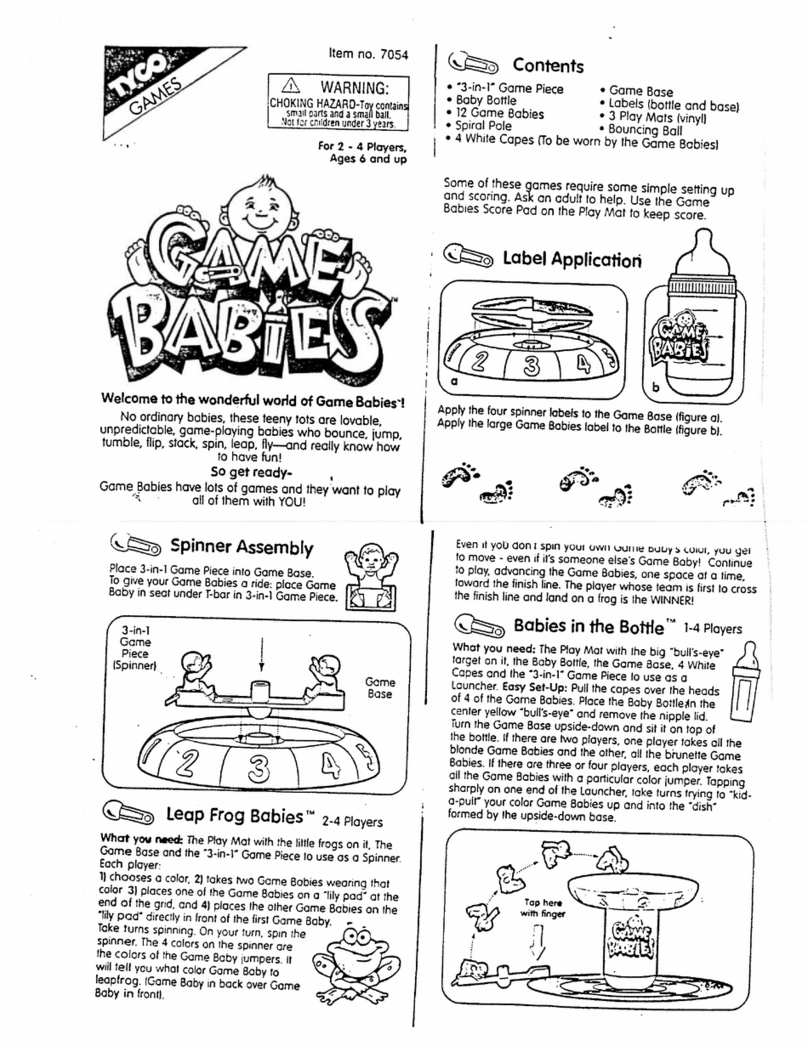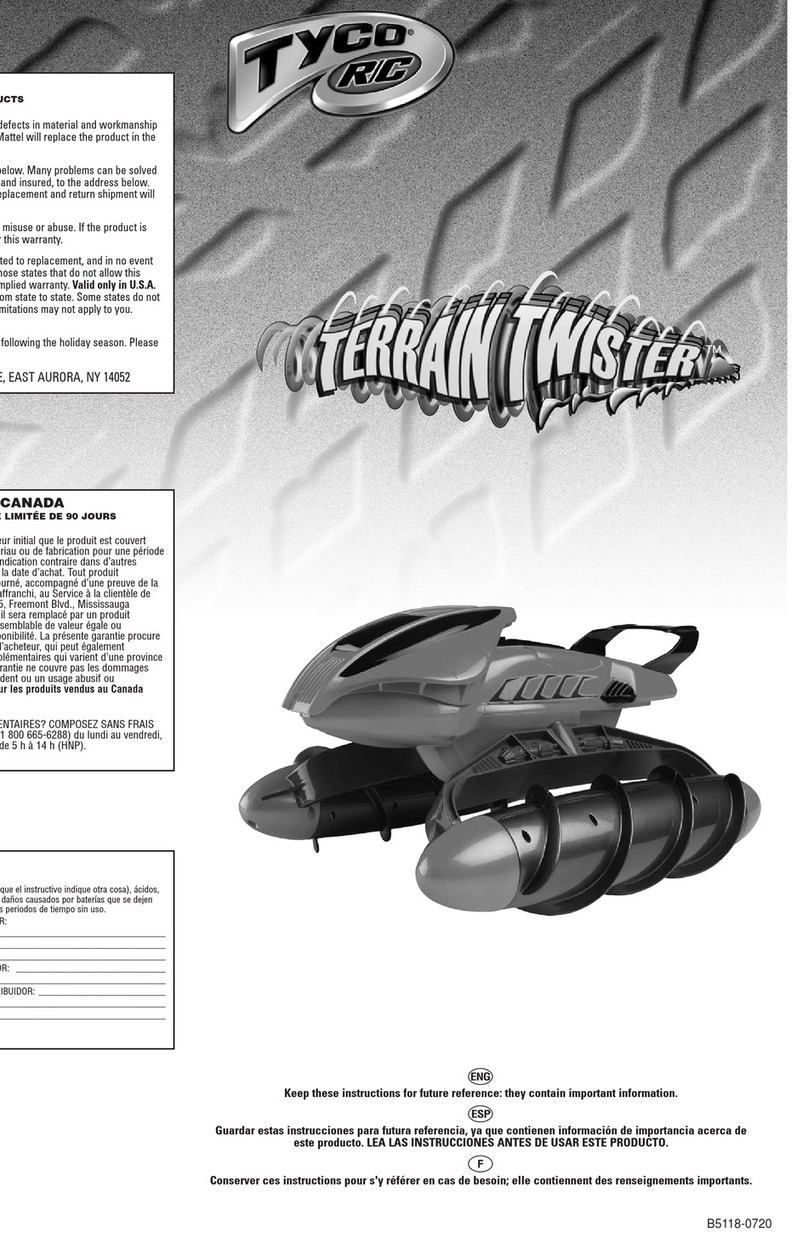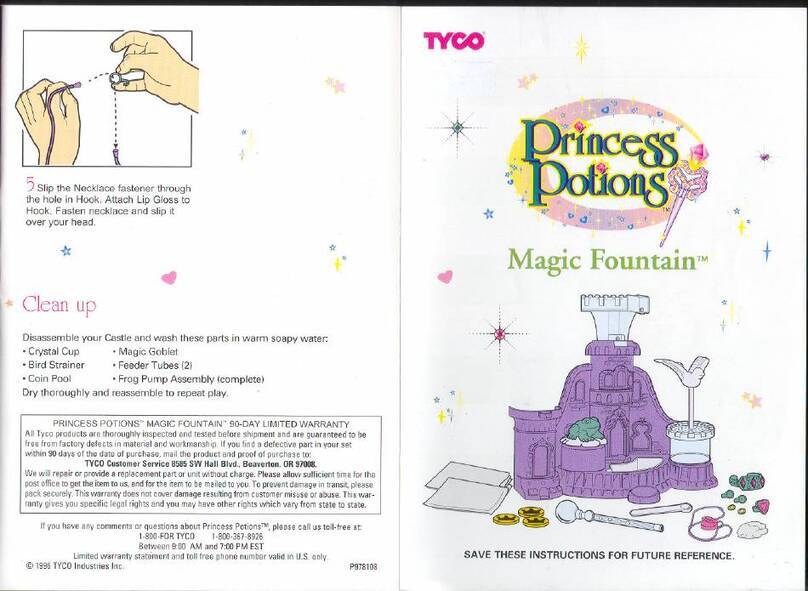7
8. Turn the transmitter OFF, then turn the
vehicle OFF. Recharge the vehicle for more
flying action.
NOTE: DO NOT activate the stop feature
during flight, except in a real emergency!
Activating this feature when the vehicle is
in the air will cause it to come down in an
uncontrolled descent. A hard landing may
damage the vehicle.
VIII. QUICK TIPS
1. Radio interference can make your vehi-
cle fly badly. Interference can be caused by
other R/C vehicles running on the same fre-
quency; electrical wires; large buildings; or
CB radios. Try to stay away from these!
2. Your flying time may change depending
on air conditions and on your flying style.
When the vehicle fails to respond, slows
down, or loses range, recharge the vehicle.
If performance does not improve following
a recharge, it may be time to charge the
Field Charger.
3. The vehicle is designed with advanced
protection circuitry that will switch auto-
matically to a controlled-descent speed, to
bring the vehicle down easily, under the fol-
lowing conditions:
(a) If the vehicle gets out of range of the
transmitter while flying;
(b) If the remaining charge in the vehicle’s
permanent battery drops too low while flying;
(c) If the control stick is released while
flying; or
(d) If the vehicle gets too hot during
operation.
4. Because your vehicle is sensitive to extra
weight, dirt or mud on the vehicle’s body
can affect its operation. Use a clean dry
cloth to remove any dirt or mud immediate-
ly. If your vehicle gets wet, it’s important not
to operate it until it’s completely dry, inside
and outside. Wipe surfaces with a towel
and allow the vehicle to air-dry until it’s
dry…overnight at least.
5. Don’t store your vehicle near heat or in
direct sunlight. Always turn switches OFF
before storing your vehicle and transmitter.
BATTERY SAFETY INFORMATION
NOTE: This section contains general infor-
mation about battery safety. For specific
information relating to the use and care of
the Field Charger, please see Section III.
Batteries may leak fluids that can cause a
chemical burn injury or ruin your toy (prod-
uct). To avoid battery leakage:
•Do not mix old and new batteries or bat-
teries of different types: alkaline, standard
(carbon-zinc) or rechargeable (nickel-
cadmium).
•Insert batteries as indicated inside the
battery compartment.
•Remove batteries during long periods of
non-use. Always remove exhausted batteries
from the toy (product). Dispose of batteries
safely. Do not dispose of batteries in a fire.
The batteries may explode or leak.
•Never short-circuit the battery terminals.
•Use only batteries of the same or equiva-
lent type, as recommended.
•Do not charge non-rechargeable batteries.
•If removable, rechargeable batteries are
used in the transmitter, they are only to be
charged under adult supervision.
•Do not dispose of the vehicle in a fire. The
permanently-installed battery inside may
explode or leak.
Battery Performance Note:
For best performance use alkaline batteries
(where disposable batteries are called for).
If your vehicle is supplied with standard
(carbon-zinc) batteries for initial use and/or
demonstration purposes, we recommend
replacing them with alkaline batteries when
necessary. Battery life may vary depending
on battery brand.
IMPORTANT INFORMATION
•DO NOT RECHARGE THE VEHICLE IF IT
FEELS HOT. ALLOW IT TO COOL BEFORE
RECHARGING.
•DO NOT ATTEMPT TO USE OR CHARGE THE
VEHICLE IF IT SHOWS SIGNS OF LEAKAGE
OR CORROSION.
•DO NOT HANDLE OR DISASSEMBLE THE
VEHICLE’S PERMANENTLY-INSTALLED
NiMH BATTERY. THE NiMH BATTERY IS A
SEALED NiMH (NICKEL-METAL HYDRIDE)
BATTERY.
•IF THE VEHICLE AND/OR FIELD CHARGER
ARE WET, THOROUGHLY DRY BEFORE
USING OR CHARGING.
•REGULARLY EXAMINE ALL WIRES AND
CONNECTORS. IN THE EVENT OF DAMAGE,
DO NOT USE.
The vehicle is powered by Nickel-Metal
Hydride technology, and requires no special
procedures or precautions for disposal.
However, as with all products, you should
dispose of your NiMH battery in an environ-
mentally responsible and considerate man-
ner. For information regarding disposal of
the Field Charger, please see Section III.
IX. SAFETY INFORMATION
Adults, this toy is recommended for children
10 years of age and older. To ensure that
the child’s play is both safe and fun, please
review the operating instructions and
these general safety rules with the child.
•Keep fingers, hair and loose clothing
away from the rotor while the vehicle is
switched ON.
•Maintain a minimum 10’/3m distance
between yourself and the vehicle during
operation.
•DO NOT operate the vehicle indoors.
•NEVER hold the vehicle while operating.
•ALWAYSlaunch the vehicle from level
ground.
•NEVER stand under the vehicle during
flight.
•During operation, maintain a minimum
10’/3m distance between the vehicle and
other people or animals.
•Keep small children away from the vehi-
cle at all times.
•In the event that the vehicle comes too
close to a person, animal or obstacle during
flight, push the control stick all the way
down to activate the stop feature.
•Adult supervision is recommended AT ALL
TIMES during operation of this toy.
•To avoid accidental operation, remove the
transmitter battery when not in use.
•If the vehicle and/or charger get wet, dis-
continue use until they are completely dry.
Thoroughly wipe off all moisture and allow
them to air-dry completely before use.
•DO NOT fly in or near the street! Make
sure you have plenty of open space in all
directions (please read Section VI carefully
before operating).
•DO NOT stand (or allow others to stand)
downwind of the vehicle while flying.
•NEVER operate the vehicle if the rotor
blades are broken or damaged. ALWAYS
make sure the rotor blades are properly
attached and the screws holding them are
fully tightened.
•NEVER operate the vehicle unless it is
fully assembled.
•NEVER throw foreign objects into the path
of the rotor.
TROUBLESHOOTING GUIDE
It takes a little flying time and practice to
become an expert. If you still have difficulty
operating your vehicle, please check this
troubleshooting guide. Usually the prob-
lem’s a simple one…with a quick solution.
IF THE VEHICLE WILL NOT FLY:
•The vehicle may need to be recharged.
Follow the instructions in Section IV.
•The Field Charger may need to be charged
(red Field Charger LED glows steadily when
you attempt to recharge the vehicle).
Follow the instructions in Section III.
•You may need to replace the transmitter
battery with a fresh alkaline battery. Follow
the instructions in Section I.
•The vehicle’s NiMH battery temperature
may be too high (red Field Charger LED
flashes when you attempt to recharge the
vehicle). Let the vehicle cool down before
attempting to fly again.
•If the rotor spins but the vehicle will not
fly, you may need to discharge and
recharge the vehicle. Follow the instruc-
tions in Section IV.
•The vehicle may still be connected to the
Field Charger. You must disconnect the
Field Charger from the vehicle before oper-
ating the vehicle. Follow the instructions in
Section IV.
IF YOU HAVE DIFFICULTY OPERATING OR
CONTROLLING THE VEHICLE:
•Check air conditions. Operate your vehi-
cle in calm, clear weather only. DO NOT
attempt to operate your vehicle in windy
conditions. Please refer to Section VI.
•Check for obstacles that may create air
currents, like tall buildings and trees. You
may need to choose an alternative place to
fly. Please refer to Section VI.
•Check the area for sources of radio inter-
ference, like other radio control vehicles,
electrical wires, large buildings or CB
radios. You may need to choose an alterna-
tive place to fly. Please refer to Section VIII.
•Check your vehicle for dirt or mud. Clean
if necessary. Please refer to Section VIII.
•Make sure the rotor blades are not bent
or deformed. Please refer to Section II.
•Make sure it is not too hot or too cold out-
side. Please refer to Section IV.
l CAUTION: Only allow children at least
10 years old to use the battery charger. The
battery charger is not a toy and should be
used only under adult supervision.




























